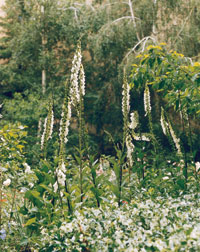S
T A N F O R D ![]() M
E D I C I N E
M
E D I C I N E
|
S
T A N F O R D |
| Volume
18 Number 2 Fall 2001 |
index
 |
|
Short
Take: Blooming
beds |
|
Most people wouldn’t think of an academic medical center as a site for a lush English garden — unless they had spent some time at Stanford University Medical Center. In a setting traditionally rife with angst, the medical center’s gardens provide a backdrop of calmness and serenity. Many are designed as places patients, faculty and staff can wander through and relax in, and as the gardens’ designer Katsy Swan explains, “They have a tremendous healing affect. All hospitals should have a place where patients and families can go outside.” Over the past 10 years, Swan has turned nearly every courtyard and entryway, more than 30,000 square feet, into a botanical tapestry. Floral displays range from wild English gardens, to serene shade settings and private atrium displays. There are even sweet peas and morning glory vines growing on an unsightly chain link fence that leads patients into the emergency room. The spring show of more than 30,000 bulbs rivals any showcase garden. Unlike wild English gardens, which go through messy or dormant periods, the hospital gardens are tended and planted year-round, providing a colorful display in the dead of winter and in the height of summer. “We are trying to make every place pretty all the time,” says Swan, “and to provide great variety in a number of small places.” In fact, many of the gardens are in trapped spaces, courtyards and atriums surrounded by steep walls, which cast long shadows for much of the winter. Swan has to be exceptionally careful in choosing plants that will thrive and look healthy in such an environment. The biggest challenge in designing the hospital garden is making it beautiful at ground level and from the floors above, so patients can enjoy the sights from their windows. “Overhead is one of the most important views,” says Swan. And one of the most difficult to make beautiful, she admits. The trees grow too big, reaching for the light, and require regular pruning so people can see the colorful plants below. In addition to the impressive floral display on the walk leading up to the entrance, plantings in 23 other areas throughout the medical center offer delight to garden lovers. Some of Swan’s favorites include the private courtyard off the psychiatric wing, the atrium gardens and a serene fountain in the radiology courtyard. Also, not to be missed are the life-sized topiary elephant, giraffe and lion standing guard in front of Lucile Packard Children’s Hospital. Swan’s selection and placement of flowers and plants — especially her ability to replicate the effect of a very personal, intimate, hand-tended garden on a scale that’s practical for an institutional setting — sets her apart from other landscape designers. But she doesn’t take all the credit. Without the vision and financial support of longtime Stanford benefactors Helen and Peter Bing, the hospitals’ gardens would likely be nothing special. “It takes extraordinary generosity to make this kind of display possible,” she says. “It is a wonderful living gift to everyone who visits here.” SM |
|
|
Home |
|
This document was last modified:
Wednesday, 31-Dec-1969 16:00:00 PST
|
|